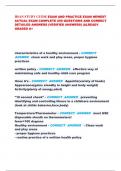HSAN STUDY GUIDE EXAM AND PRACTICE EXAM NEWEST
ACTUAL EXAM COMPLETE 250 QUESTIONS AND CORRECT
DETAILED ANSWERS (VERIFIED ANSWERS) |ALREADY
GRADED A+
characteristics of a healthy environment - CORRECT
ANSWER clean work and play areas, proper hygiene
practices
written policy - CORRECT ANSWER effective way of
maintaining safe and healthy child care program
three A's - CORRECT ANSWER Appetite(variety of foods)
Appearance(gains steadily in height and body weight)
Activity(plenty of energy,alert)
"10 second check" - CORRECT ANSWER preventing
identifying and controlling illness in a childcare environment
(look at childs behavior,face,body)
Temperature/Thermometer - CORRECT ANSWER must USE
disposable sheath on thermometers!
fever=100 degrees
Healthy environment - CORRECT ANSWER - Clean work
and play areas
- proper hygiene practices
- routine practice of a written health policy
,Written policy - CORRECT ANSWER Effective way of
maintaining a safe and healthy child care program
Three A's of a Healthy Child - CORRECT ANSWER -Appetite
-Appearance
-Activity
"10 second check" - CORRECT ANSWER Look at a
child's.......
- behavior
- face
- body
What is the purpose of Daily Health Checks? - CORRECT
ANSWER It is a way of preventing, identifying, and
controlling, illness in a child care environment
Temperature/Thermometer - CORRECT ANSWER -
Disposable sheath must be used
- can be taken orally or auxiliary (under arm)
Fever - CORRECT ANSWER Over 100 degrees Fahrenheit
Dehydration (1) - CORRECT ANSWER - Excessive loss of
water
- symptoms: dry mouth, no tears, less activity, sunken eyes,
cool and blotchy hands and feet
Heat Exhaustion (2) - CORRECT ANSWER - caused by
excessive sweating
- symptoms :pale skin, dizziness,rapid heart rate
- notify parents
,Heat stroke (3) - CORRECT ANSWER - Body does not
regulate temperature
- symptoms: hot dry skin and strong rapid pulse
- call 911 !!!!
What are communicable diseases? - CORRECT ANSWER
Disease that can be spread from one person to another
What are communicable diseases caused by? - CORRECT
ANSWER - Bacteria
- Virus
- Fungi
- Parasites
Bacteria - CORRECT ANSWER Small organisms that
antibiotics helps stop growth of
- examples: strep throat, pink eye, pneumonia
Virus - CORRECT ANSWER - Smaller organisms that
vaccines go against
- antibiotics have no effect, body fights
- examples: colds, chicken pox, measles
Fungi - CORRECT ANSWER - Grow in moist areas
- medication is available
- examples: ringworm, athletes foot
Parasites - CORRECT ANSWER - organisms that live on
people
- examples: lice, pinworms,roundworms
, chicken pox symptoms (virus) - CORRECT ANSWER Fever,
blisters, first on scalp, then on face and body
Common cold symptoms - CORRECT ANSWER Runny nose,
watery eyes, chills, no fever, fatigue
Influenza - CORRECT ANSWER High fever, chills,
headache, sore throat, chest pain, muscle pain
diarrhea related disease symptoms - CORRECT ANSWER
Loose or watery stools, nausea, vomiting, fever,
stomachache, headache
Conjunctivitis (pink eye) - CORRECT ANSWER - Red eye(s)
-crusted lids
- discharge from eyes
Giardiasis - CORRECT ANSWER - Parasite found in stool
- Diarrhea, Abdominal cramps, bloating, weight loss,
weakness
allergic reaction - CORRECT ANSWER rash, itching,
swelling, difficulty breathing
RSV (respiratory syncytial virus) - CORRECT ANSWER
highly contagious viral respiratory infection
- blue lips, rapid breathing, coughing
Lice - CORRECT ANSWER Itchy scalp, eggs, red bumps,
sores from scratching




